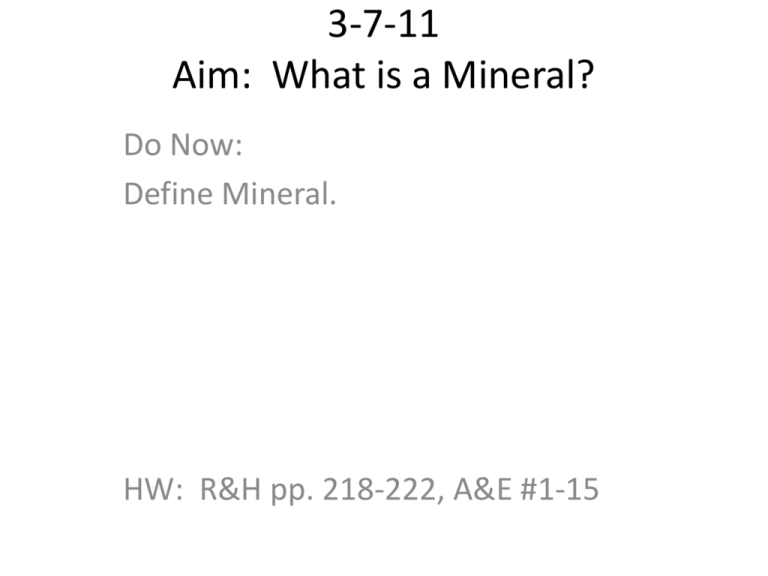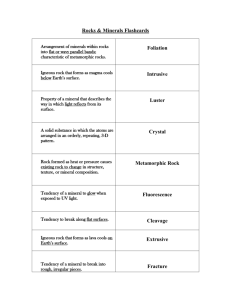3-7-11 Aim: What is a Mineral?
advertisement

3-7-11 Aim: What is a Mineral? Do Now: Define Mineral. HW: R&H pp. 218-222, A&E #1-15 • • • • • Mineral- a mineral is a naturally occurring, inorganic, solid, with a definite chemical composition and crystal structure. Naturally occurring- happens on its own in nature without human assistance. Inorganic- not living and is not made of living things. Solid- definite shape and definite volume Definite chemical composition- the same mix of elements all the time. Definite crystal structure- atoms arranged in a repeating pattern that forms a crystal shape. Mineral Properties and Identification. A mineral’s physical properties are based on its internal arrangement of atoms • Color- what color the mineral appears- not the best test because many minerals have the same color and impurities may affect the color. • Streak- shows the mineral in its powdered form against a white tile. A better sense of the minerals color. • Luster- the way a mineral reflects light. There are many lusters but we will look it metallic (looks and shines like metal) or nonmetallic ( does not). • Hardness- a minerals’ resistance to scratching. Mineral Identification cont’d. • Density- how compact the molecules are D= M/V. • Cleavage- the tendency of a mineral to break along flat planes. A mineral can have 0,1,2,or 3 planes of cleavage. A plane is a direction of break and if there are 3 than the shape is cubic. • Crystal Structure- the way the atoms are arranged creates a definite repeating crystal shape. • Special properties- some minerals have a distinct smell, are magnetic, can glow in the dark or something else unique to the mineral that helps to identify it. Also some minerals will react with certain chemicals i.e. hydrochloric acid will fizz in the presence of calcite. 3-10-11 Aim: What is a Sedimentary Rock? • Do Now: Read p.219 “Mineral Crystal Structure” and diagram on p.220. • 1. What is a tetrahedron? • 2. What is a tetrahedron made up of? • 3. What is the tetrahedron responsible for? • HW- R&H pp. 223-226 Rocks-solid substances containing 1 or more minerals. All rocks contain minerals. • Monominerallic- rocks containing one mineral type only (can be both a mineral and a rock. • Polyminerallic- most rocks contain a mixture of minerals, not in definite amounts. • Rock Types- there are three types of rocks that differ in their environment of formation (R.T. p.6). Sedimentary, Igneous, Metamorphic. Sedimentary Rocks- form from the depostion, buriel, compaction and cementation of sediments. • Sedimentary rocks are formed at or near the earth’s surface, usually under large bodies of water. • Sediments are deposited, buried by other sediments forcing them to compact. Then minerals dissolved in the water work as a glue to cement the sediments together creating a sedimentary rock. See R.T. p.7 for these rocks. • The sediments can be broken pieces of other rocks, shells, plant and animal remains, or chemical precipitates or evaporites ( the solid left after water evaporates). How to identify a sedimentary rock? • Texture – grain size- measure the size of the grains in the rock (clay, silt, sand, pebbles, etc.) • Layers of sediment. • Cemented together……….. Could be sediments, shells, fossils or crystals from chemical precipitates or evaporites Sedimentary Rocks 3-14-11 Aim: What is an Igneous Rock? • Do Now: • 1. What is an evaporite and give an example of a rock that results? • 2. What is a precipitate and give an example of a rock that results? • 3. What are the two organic sedimentary rocks on the R.T.? • HW- Finish Igneous Rock Lab Igneous rocks form from the Solidification of Magma • What determines the size of the crystals in an igneous rock is how fast the magma cools. • The longer it takes to cool the bigger the crystals have an opportunity to grow. • Rock cools slowly deep below the surface creating large intergrown crystals. • Rock cools quickly at the surface forming small to no crystals. • Quiet lava flows produce glassy igneous rock (noncrystalline), while explosive eruptions produce vesicular rock (containing gas pockets) • If the cooling rate of magma gets interrupted by another lava flow you can get a rock that has fine crystals with larger ones mixed in (porphyritic). Igneous Rocks 3-15-11 Aim: What is a Metamorphic Rock? • Do Now: 1. Where and how does a rock with large intergrown crystals form? 2. As cooling time increases crystal size_______. HW: R&H pp.226-232, A&E # 16-37, Topic 11 exam Thursday. Metamorphic Rocks form as a result of heat and pressure or chemical change to pre-existing rocks. • Can form deep underground where the heat and pressure is great causing recrystallization without true melting. • Rocks are distorted in structure- could be crystal distortion, fossil distortion, layer distortion • Rocks are baked under the heat and pressure and become foliated (the appearance of peelable layers), could be fine, medium or course foliation. Types of Metamorphism (2) 1. Regional Metamorphism- when a large area is pushed further down in the crust resulting in tremendous heat and pressure. 2. Contact Metamorphism- when rock comes in contact with an igneous intrusion the rock touching the intrusion gets heated and pressurized creating zones of metamorphic rock. Metamorphic Rocks 3-16-11 What is a Mineral Resource? • • • • Do Now: R&H pp.234-237 1. Answer aim question. 2. What is a renewable vs. a nonrenewable resource? 3. What is a fossil fuel and are they renewable or nonrenewable? • 4. Why does metamorphic rock tend to be more dense than the other types of rock? • 5. What is foliation? • HW: A&E p.237 #38-47, study T.11 for exam Friday.






